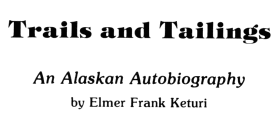Freighting to Gold Bench
On the first of June, 1944, Victor Neck and I bought one hundred fifty pounds of groceries and Morris King flew us to Tramway Bar, twelve miles from Gold Bench. With a seventy five pound pack each, we hiked over the hills to our property. We spent all of June and part of July panning the gravel bars up and down the river. Victor wanted to check out his cabin on Emma Creek so we hiked the forty miles to Wiseman. Morris King flew us back to Fairbanks.
The rest of the summer was spent overhauling the tractors in the big shop that we built out of logs. Using big timbers for skids we built ten go-devils (sleds) with steel runners.
This was all in preparation for a cross country freighting trip to our mine on Gold Bench. A thousand barrels of fuel oil, gasoline, grease, etc. and a lot of building materials for a camp were waiting at Stevens Village, all of which had been ordered from Seattle the previous summer.
We headed north on the fifth of February with three D-8s, a D-7 and a D-6 towing our sleds, the ten go-devils, as well as a Byers dragline that we bought in Fairbanks.
The numerous glaciers across the highway from Fairbanks to Livengood gave us a rough time. Water running continuously from warm springs above the road formed these glaciers, some of them so steep that we had to pick and shovel a trough for the upper side cat track and sled runner to prevent sliding sideways over the bank. This was still easier than breaking a new trail through the heavy brush and timber.
Wien Airlines was flying tractor sleds with D-3 airplanes to Point Barrow for the Navy oil exploration. I was on the lead cat on night shift going on a long straight stretch with the four cats following. The pilot of the Wien plane returning to Fairbanks saw the line of tractor lights so I he throttled down the engines, dived down to about a thousand feet right I in front of me, put on his landing lights and opened his throttles. As I World War Two was still on, we all nearly went through the floor boards, I thinking the Japanese were going to strafe us. I
Having flown over the route several times and memorizing land marks, I took the job of breaking trail north from Livengood. I intended to hit I Stevens Village as close as possible so we would not have to go up or down the Yukon River flats, knowing that they were full of big willows and timber.
While going down Hess Creek over the hill 9 it began to snow so thickly that I could not see any of my landmarks. Climbing a hill made no I difference in vision. Taking out a compass, I snowshoed ahead to get away from the steel tractor for a more accurate reading. The ridge went too far to the north east. Dropping off this hill, I climbed another. The compass showed straight north so I kept going down the hill alongside a creek, hoping it ran toward Stevens Village. After several hours the snowstorm quit. The big flat country looked as if it might be the Yukon flats. Leaving the cat and following some snowshoe tracks led me to a trapper by his cabin.
“What in the world is going on?” he asked. “I’ve been hearing that roaring sound for a long time.”
I told him, after which he informed me that I was forty miles upriver from Stevens Village. It was too late to turn back so I headed west into a jungle of big, twisted willows and trees, the toughest trail breaking I had ever tackled. About twenty miles later the going was better with few trees and no big willows.
Again a snowshoe track crossed my trail so I got off to follow it for about half a mile. Two natives were standing in front of their cabin on the bank of the Yukon. I asked them how far to Stevens Village. They pointed straight across the river.
By the time I got back to the tractor the rest had caught up with me. After parking there for the night, we moved everything to the river in the morning and drilled the ice. It was only twelve inches thick. Drilling up and down the river found no thicker ice.
A red Bellanca airplane circled over and landed on the river in front of us. It was Morris King of Alaska Airways, a pilot who had done a lot of flying for us.
“Elmer, where in heck are you trying to go? If you cross here you will have a trip twice as far to Stevens Village around a big bend of the river. Get in the plane, I will take you up and show you where to go.”
We flew down river for quite a distance and it was all open country to Stevens Village. Those Indians really gave me a wrong steer.
About twenty miles downstream we drilled the ice again, finding it not very thick. Hooking our oldest cat to a sled with a long cable we sent it straight across slowly in low gear, then climbed on it on the other side. After sending all the tractors and loads across, only half a mile remained to the village.
Most of the Indians came to meet us, some with dog teams and some on snow shoes. We were an exciting event in their quiet life.
Using the Byers Crane to lift the oil barrels and heavy items, we spent a few days loading all there was room for.
I again headed north breaking trail toward the hills to a bluff which was one of the landmarks. The Dall River came to the Yukon flats near this bluff. Between that and the Dall River, boiling hot springs were close together, making it difficult to find places frozen and wide enough to get through.
We went up the Dall River about ten miles, turning up a ravine, stopping for the night just before Old Man Flats. The next morning huge snow drifts faced us but finally a place was found to get to the flats without crossing the drifts. We encountered no more trouble before Gold Bench.
The round trip to Stevens Village was about a hundred miles by our trail. It took two more trips to haul all the stuff.
On the second trip coming up the ravine from the Dall we stopped for the night again just before entering the flats. Sounds of tractors came from behind us. It was Lytle and Green Construction Company following our trail from Fairbanks, hauling graders, scrapers, trucks, oil and other supplies to Bettles where they had a contract to build a Federal Aviation Authority airport. They had a beautiful outfit, all new D-8 cats and sleds. They said they were going on into Bettles that night.
The next morning we found them with all their cats stuck in the huge drifts on the edge of the flats. Our trail was blown full so they could not see where we had turned east. We offered to help but they said they would get out o.k.


